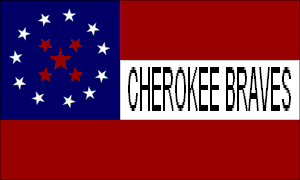1st Cherokee Mounted Rifles
| 1st Cherokee Mounted Rifles (Confederate) | |
|---|---|
|
1st Cherokee Mounted Regiment flag | |
| Active | July, 1861-June 23, 1865 |
| Country |
|
| Allegiance |
|
| Branch | Cavalry |
| Size | Regiment |
| Garrison/HQ | Fort Wayne (Indian Territory) Cherokee Nation |
| Nickname | Watie's Regiment |
| Equipment |
Rifles & Carbines Mississippi Rifle Brown Bess Kentucky Rifle Sharps Rifle Spencer Rifle Gallager Carbine Maynard Carbine Springfield Rifle Sabers M1860 Light Cavalry Saber Pistols M1858 Remington M1860 Colt Army M1851 Colt Navy |
| Engagements |
Battle of Pea Ridge Battle of Old Fort Wayne Battle of Cabin Creek |
| Commanders | |
| Notable commanders |
Brig. Gen. Stand Watie Col. John Drew Lt. Col. William P. Ross Maj. Thomas Pegg |
The 1st Cherokee Mounted Rifles was a Confederate States Army regiment which fought in the Indian Territory during the American Civil War. One of its commanders was Stand Watie.
Confederate officials commissioned Stand Watie a colonel in the Confederate States Army in July 1861 and authorized him to raise the First Regiment of Cherokee Mounted Volunteers. Cherokee Chief John Ross signed the Cherokee-Confederate treaty of alliance in October 1861 and raised the First Regiment of Cherokee Mounted Rifles, commanded by Col. John Drew. At this time Watie's regiment became the Second Regiment of Cherokee Mounted Rifles.
A portion of Drew's regiment deserted in late 1861. Following the Battle of Old Fort Wayne in October 1862, most of the remainder of Drew's men deserted. What remained of his troops was combined with Watie's regiment and reorganized as the First Regiment of Cherokee Mounted Rifles with Watie in command.
During the Civil War, Watie's troops participated in twenty-seven major engagements and numerous smaller skirmishes. Although some of the engagements were set-piece battles, most of his activities utilized guerrilla tactics. Watie's men launched raids from south of the Canadian River throughout northern-held Indian Territory and into Kansas and Missouri, tying down thousands of Union troops. Poorly equipped and armed mostly with castoff rifles or captured weapons, the Cherokees were well suited to this type of warfare. Watie was promoted to brigadier general in May 1864.
Watie's most spectacular victories included the capture of a Federal steamboat, the J. R. Williams, in June 1864 and the capture of a Union wagon train at the Second Battle of Cabin Creek in September 1864. His three most infamous actions were the burning of Rose Cottage, home of Chief John Ross, and the Cherokee Council House in October 1863, and the massacre of the First Kansas Colored Infantry and 2nd Regiment Kansas Volunteer Cavalry at the Hay Camp Action (a.k.a. the Battle of Flat Rock) in September 1864.[1]
In February 1865 Watie was given command of the Indian Division of Indian Territory but was unable to launch any offensive operations. He released most of his troops following the collapse of Confederate resistance in the spring of 1865. After participating in the Camp Napoleon Council in May, Stand Watie officially surrendered on June 23, 1865, becoming the last Confederate general to lay down his arms.
Battle of Pea Ridge
This battle was on March 6–8, 1862 in Benton County, Arkansas with a Union victory.
Battle of Old Fort Wayne
This battle was on October 22, 1862 in Fort Wayne, Indian Territory with a Union victory.
Battle of Cabin Creek
This battle was on July 1–2, 1863 in Mayes County, Oklahoma with a Union victory.
See also
References
- ↑ "WAGONER COUNTY". Digital.library.okstate.edu. Retrieved November 29, 2014.
